October 2020
The Pay Attention Games
Emily Keebler, a fifth-year graduate student working with Dr. Anna Fisher, is studying how children learn to manage waiting patiently and to control impulses. Young children grow rapidly in these important self-regulation skills, facilitating their increased cooperation and collaboration in many group settings. In some situations, it is important to delay or stop an impulsive response. In other situations, one must not only stop a response but also produce a less expected one. All of this requires paying attention to situational cues. In Emily’s series of Pay Attention Games, children participate with their words and bodies in matching, movement, and naming activities. By comparing different age children’s sustained attention and inhibition, the researchers will learn how these skills develop.
While conducting research, Emily will be following all of the Children’s School risk mitigation strategies, which she learned by joining the staff training sessions discussed earlier. To keep interactions to a minimum, Emily will be the only researcher, and she will work with only one class at a time and only a handful of children each week. As always, children’s time in the lab each day is less than 20 minutes. While in the lab, the child and researcher will be separated by distance as much as possible and also by a plexiglass partition.
DAY ONE
Shape Game: Children match geometric shapes using a sanitized computer keyboard. Trials vary in how much attentional control they require due to varying color/shape combinations.
Animal Matching Game: In this game, children search for animal pairs on their screen. There’s a twist in the second half of the game to keep the children on their toes.
Puppet Game: The researcher introduces two animal puppets in this game. Then both characters give children commands such as touch your nose, clap your hands.
DAY TWO
Head and Toes Game: Children get up and moving as they follow the researcher’s directions in this whole-body listening game. Children often find this one to be quite silly!
Wolf and Pig Game (Session 1): Children help to keep fictional pigs safe from wolves in this digital game! Their participation helps us to learn about how attention is deployed over time.
DAY THREE
Statue Game: In this game, children get to “freeze like a statue.” We’ll ask that they stand still and close their eyes while we play this whole-body game.
Wolf and Pig Game (Session 2): Children will play another round of the Wolf and Pig Game. Changes to the task characteristics, relative to Session 1, will help us to learn even more about children’s sustained attention.
DAY FOUR
Sorting Game: Children sort by color to create apple baskets, flower bouquets, and more in this digital task. The children stay alert to task directions, such as what to do when a worm appears!
Colorful Foods Game: Children play with unexpected images in this naming game. Care for an orange kiwi, anyone?
Picture Matching Game: In this digital activity of close looking, children identify line drawings that match target images.
November 2020
Functional Near InfraRed Spectroscopy (fNIRS)
Professor Marlene Behrman’s research team will begin using functional Near Infrared Spectroscopy (fNIRS) techniques for investigating visual recognition of objects and faces among children whose parents have given permission. This technique has been approved by CMU’s IRB as a minimal risk procedure for use with young children, but the research permission form that families signed for the 2020-2021 school year does not cover its use. Thus, parents had the option to sign a separate consent form for participation in fNIRS studies, and only those children may participate.
 fNIRS records brain activity by measuring changes in blood flow in a given region of the brain. Changes in blood flow are measured by emitting infrared light into the scalp and underlying tissues, including the surface of the brain, at a frequency that is primarily absorbed by blood. By detecting the amount of light that is absorbed, we can infer changes in blood flow over the course of a cognitive task. Light is emitted and detected by diodes positioned on the scalp and held in place with a soft cap. The benefit of fNIRS is that it allows the child to sit and move comfortably while doing the task. The near infrared light exposure is comparable to sun exposure MINUS the UV wavelengths. The researchers use health and safety protocols to ensure that the caps are free from lice and that the light never shines in the children’s eyes. Extra precautions are being included in the procedures as COVID risk mitigation, including both researcher and child wearing facial coverings, the researcher also wearing a face shield and gloves, and the researcher staying physically distant from the child after securing the diodes and cap.
fNIRS records brain activity by measuring changes in blood flow in a given region of the brain. Changes in blood flow are measured by emitting infrared light into the scalp and underlying tissues, including the surface of the brain, at a frequency that is primarily absorbed by blood. By detecting the amount of light that is absorbed, we can infer changes in blood flow over the course of a cognitive task. Light is emitted and detected by diodes positioned on the scalp and held in place with a soft cap. The benefit of fNIRS is that it allows the child to sit and move comfortably while doing the task. The near infrared light exposure is comparable to sun exposure MINUS the UV wavelengths. The researchers use health and safety protocols to ensure that the caps are free from lice and that the light never shines in the children’s eyes. Extra precautions are being included in the procedures as COVID risk mitigation, including both researcher and child wearing facial coverings, the researcher also wearing a face shield and gloves, and the researcher staying physically distant from the child after securing the diodes and cap.
Undergraduate Laboratory Courses
Because Dr. Anna Fisher’s Developmental Research Methods students have been learning remotely this fall, they are learning research techniques for analyzing video archive data. At this point in the semester, they are working on final projects of their own design. One team is investigating children’s attention and engagement levels during circle time, so Miss Drash created a video archive of circle time recordings with entries from our Preschool 3’s, Preschool 4’s, PreKindergarten, and Kindergarten classes. In this way, the students can compare the attention and engagement of children based on their age, based on the beginning-middle-end segment of circle time, based on the type of activity (e.g., reading vs. singing), etc. They also aim to determine when the children’s distractions are caused by peers, the environment, or whether they actually distract themselves (e.g., fussing with clothing, wiggling a tooth, etc.).
 Looking ahead, neither the Developmental Research Methods nor the Practicum in Child Development courses will be taught in the Spring of 2021. The Principles of Child Development course will be taught but with remote observations, as described in last month’s Research Spotlight.
Looking ahead, neither the Developmental Research Methods nor the Practicum in Child Development courses will be taught in the Spring of 2021. The Principles of Child Development course will be taught but with remote observations, as described in last month’s Research Spotlight.
December 2020
Grammar Learning Cues in Social Interaction
(The Dream Machine Game)
First year doctoral student Megan Waller is studying the ways that children learn grammar from social interaction, with guidance from Professors Bonnie Nozari and Dan Yurovsky in CMU’s Psychology department. Lessons in a classroom are not the only opportunity children have to learn correct grammar. Interactions with parents and other adults also provide opportunities for children to get feedback on their mistakes. While children rarely hear explicit corrections of their grammatical errors, they do get more subtle signals. For example, parents may reformulate their child’s incorrect utterance, i.e., repeat it with corrected grammar (Hirsh-Pasek, Treiman & Schneiderman,1984; Chouinard & Clark, 2003). For example, if a child says, “The dog runned!”, a parent might answer, “Yes, the dog ran!” Another potential signal for children is a difference in how long it takes people to respond to them. The researchers’ previous study shows that when children produce an incorrect past tense verb like “I runned!”, adults are slower to respond than when they use the right past tense form ("I ran") because the incorrect form is surprising and more effortful for adults to understand. In the current study, they are investigating whether children can use a difference in response time to learn grammar.
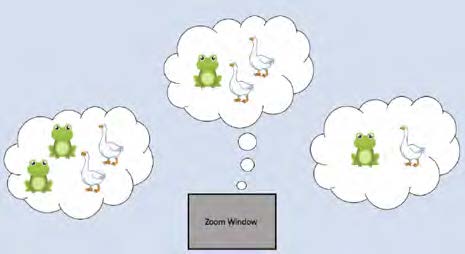 During the study, which will be conducted remotely via Zoom, children play a game designed to examine whether adults’ slower response times after erroneous utterances is a noticeable cue for children, and whether they can use this timing difference to learn from their mistakes. The Dream Machine Game involves using irregular plural nouns (e.g., geese and mice) that are difficult for children, and sometimes even adults. The experimenter explains that they’ve built a dream machine that replays the experimenter’s dreams, and that the experimenter needs the child’s help to finish fixing it. The child first is asked to name each of the possible images to verify they know the correct nouns. Then, when the trials begin, a beep signals the start of each trial, and the child is shown three sets of pictures like the image here. They are asked to identify the pictures in the dream cloud with a trail of bubbles by counting how many of each picture was in the experimenter’s dream. In this example, the child would be expected to say, “one frog and two geese.”
During the study, which will be conducted remotely via Zoom, children play a game designed to examine whether adults’ slower response times after erroneous utterances is a noticeable cue for children, and whether they can use this timing difference to learn from their mistakes. The Dream Machine Game involves using irregular plural nouns (e.g., geese and mice) that are difficult for children, and sometimes even adults. The experimenter explains that they’ve built a dream machine that replays the experimenter’s dreams, and that the experimenter needs the child’s help to finish fixing it. The child first is asked to name each of the possible images to verify they know the correct nouns. Then, when the trials begin, a beep signals the start of each trial, and the child is shown three sets of pictures like the image here. They are asked to identify the pictures in the dream cloud with a trail of bubbles by counting how many of each picture was in the experimenter’s dream. In this example, the child would be expected to say, “one frog and two geese.”
After children make their response on each round of the game, the experimenter reinforces the correct response; and for half of the children in the study, the experimenter takes longer to respond when the child makes an error, while for the other half, the experimenter takes the same amount of time no matter what the child says. All children are asked to produce each irregular plural twice, and the researchers will examine whether children who receive timing as a cue for error improve their performance compared to the control children. The researchers will save the audio recordings of each Zoom session to log whether the child produced a grammatical or ungrammatical utterance and to measure the response times of both the child and the experimenter during the 26 trials. The results of this experiment will help the researchers understand whether children are sensitive to this timing difference, and whether or not it is useful as they learn the complex rules of the grammar in their native language.
January 2021
When Less is More in an Increasingly Busy World
Have you ever entered a Zoom meeting with the intention of fully focusing, only to find yourself answering emails, checking your calendar, or reading the news? Do you remember what you learned from that meeting? Neither do we. When attention is divided between multiple tasks, learning decreases. Living in a world full of distractions might make it especially difficult for students to focus, and the learning context plays a significant role.
The education market is saturated with storybook products, primarily targeting children. A common design of beginner reader (~Grades 1-2) storybooks often includes entertaining and fun looking pictures. However, nonessential pictures unrelated to the story text—also known as extraneous illustrations—might be counterproductive as they may distract a child from focusing on learning the content. To add a layer of complexity, attention skills are still developing during the time when children begin formal reading instruction.
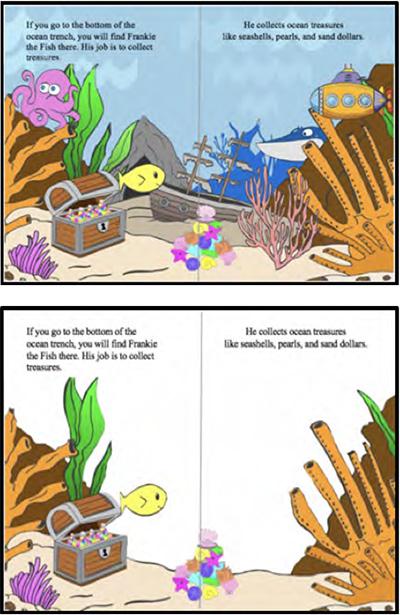
Graduate student Cassie Eng and collaborators Dr. Karrie Godwin and Dr. Anna Fisher’s examined whether extraneous illustrations in educational materials that are intended to engage a child’s interest, might do so at the cost of disrupting their attention and learning (See their research study, which was pilot tested at the Children’s School, Keep it simple: streamlining book illustrations improves attention and comprehension in beginning readers). Children in first and second grade read a commercial “Standard” book designed for beginner readers that intermixed extraneous with relevant illustrations (top right) and a “Streamlined” book presented without extraneous illustrations (bottom right). They measured children’s eye gaze patterns with a portable eye tracker, and afterwards, asked the children some questions about the story. Children who read the Standard Commercial book learned less and were more easily distracted, as indicated by their eye-tracking patterns. This pattern was consistent across both 1st and 2nd graders and demonstrated how books designed like the Streamlined version might benefit beginner readers at different stages of development. Children’s reading comprehension scores in the Standard condition were also associated with their attention allocation; the more children looked away from the text while reading, the lower their comprehension scores were.
You might wonder how researchers decided which illustrations were extraneous. They conducted a calibration study with adults who were presented with the Standard Commercial book and given instructions to outline the illustrations they believed were relevant to the story. When 90% or more of the adult readers agreed the illustrations were relevant to the story, those illustrations were retained in the Streamlined condition, while the remaining ones were deemed as extraneous. This study provides insight into optimal book design for beginner readers, which may help enhance young children’s reading experiences and improve their learning. Remote learning during the pandemic has accelerated the necessity for children to become autonomous readers, so a greater understanding of book design practices is needed to accommodate this demand.
February 2021
The Naming Game
Dr. Anna Fisher and Dr. Bonnie Nozari are collaborating on studies of word learning with the help of research associate Tania Dhaliwal, beginning with two studies conducted remotely this spring. When individuals produce words, their ability to select the correct word from memory is affected by the words they produced previously, and whether the items for these words are related to each other (e.g., dog and cat, or dog and bone) or whether they are unrelated (e.g., dog and fork). The researchers are interested to see how these relationships affect word learning in children.
The aim of the initial study is to test children’s familiarity with items that the researchers could use in future word learning studies for young children. In the Naming Game, children will be introduced to the game and asked to help the researcher name some things. The researchers will present the child with pictures of familiar items, such as animals, fruits, and furniture, one-by-one and ask the name of those items in English. The results of this study will help the researchers choose age-appropriate items for future word learning studies.

The “Poko Teaches New Words” Game
The second study investigates how relationships between words affect word learning in children. This study is designed to explore how word learning is affected differently if the items in a group are related in a way that they share features (e.g., dog and cat are both animals, have four legs, etc.), or if the items in a group share a similar context (e.g., dog and bone have no shared features but are likely to occur together in the world), or if the items are unrelated to each other (e.g., dog and fork).
 The researchers will first introduce children to a picture of an alien named Poko and tell a story about Poko visiting Earth and wanting to teach them a few words in his own language so that he can talk to them. The researchers then give pictureword pairs with pictures of familiar objects and new words that do not exist in the English vocabulary. They ask children to repeat the new words twice after hearing them. Next, they ask children to recall those words in a picture naming task like the one above and also to match the correct picture to the word that they hear in the word-matching task. Based on prior research, the researchers expect that the children will have more difficulty naming items that they learned together with other items that are strongly related to each other, compared to items that they learned together with other items that are more weakly related. The results of this study will help the researchers better understand which practices are more effective in word learning in children, as well as predict second language learning in adults.
The researchers will first introduce children to a picture of an alien named Poko and tell a story about Poko visiting Earth and wanting to teach them a few words in his own language so that he can talk to them. The researchers then give pictureword pairs with pictures of familiar objects and new words that do not exist in the English vocabulary. They ask children to repeat the new words twice after hearing them. Next, they ask children to recall those words in a picture naming task like the one above and also to match the correct picture to the word that they hear in the word-matching task. Based on prior research, the researchers expect that the children will have more difficulty naming items that they learned together with other items that are strongly related to each other, compared to items that they learned together with other items that are more weakly related. The results of this study will help the researchers better understand which practices are more effective in word learning in children, as well as predict second language learning in adults.
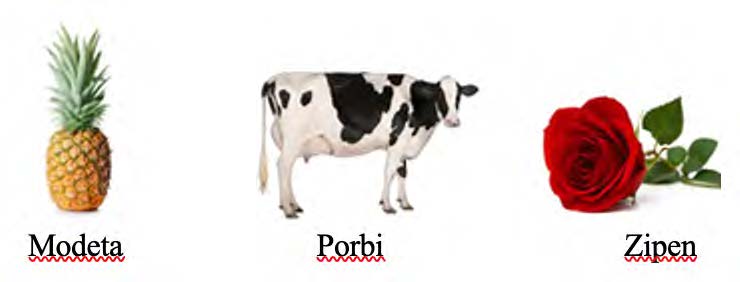
March 2021
The Matching Game
 Research Associate Emma Gurchiek is conducting a study via Zoom as part of Dr. Anna Fisher and Dr. Catarina Vales’ investigation of how children’s knowledge in the domain of animals supports their ability to make inferences in that domain. In this study, children will be asked to complete two games: In the first game, children will help a bear sort cards on their computer screen and arrange the cards based on what they think goes together. We can use the spatial distance between items to infer which items a child thinks are more strongly related. In the second game, children will help a friendly alien learn about the plants and animals on Earth by indicating which animals are more likely to share properties. Children will be told that an animal has a fictional property (e.g., ‘hydracan eyes’) and then be asked which of two other things may also share that property (e.g., another animal or a plant). Using these two games, researchers can examine how children’s knowledge of animals underlies their guesses about unobservable properties of animals. The results of this study will help us better understand the way that children use their existing knowledge to learn new information.
Research Associate Emma Gurchiek is conducting a study via Zoom as part of Dr. Anna Fisher and Dr. Catarina Vales’ investigation of how children’s knowledge in the domain of animals supports their ability to make inferences in that domain. In this study, children will be asked to complete two games: In the first game, children will help a bear sort cards on their computer screen and arrange the cards based on what they think goes together. We can use the spatial distance between items to infer which items a child thinks are more strongly related. In the second game, children will help a friendly alien learn about the plants and animals on Earth by indicating which animals are more likely to share properties. Children will be told that an animal has a fictional property (e.g., ‘hydracan eyes’) and then be asked which of two other things may also share that property (e.g., another animal or a plant). Using these two games, researchers can examine how children’s knowledge of animals underlies their guesses about unobservable properties of animals. The results of this study will help us better understand the way that children use their existing knowledge to learn new information.
Circle Time Engagement
Susanna Hur, Anastasia Wass, and Madison Williamson, students in the fall 2020 Research Methods in Child Development course, used remote observation to complete their final project. See their poster here, notice that ALL the children are very engaged in circle time, especially given their young age, and ask yourself why the older children might be somewhat less engaged than the younger ones. There are MANY factors besides age that contribute to circle time engagement, and the educators are always seeking the “sweet spot” of optimal interest and challenge level for the group. Congratulations to the students on a very intriguing study!
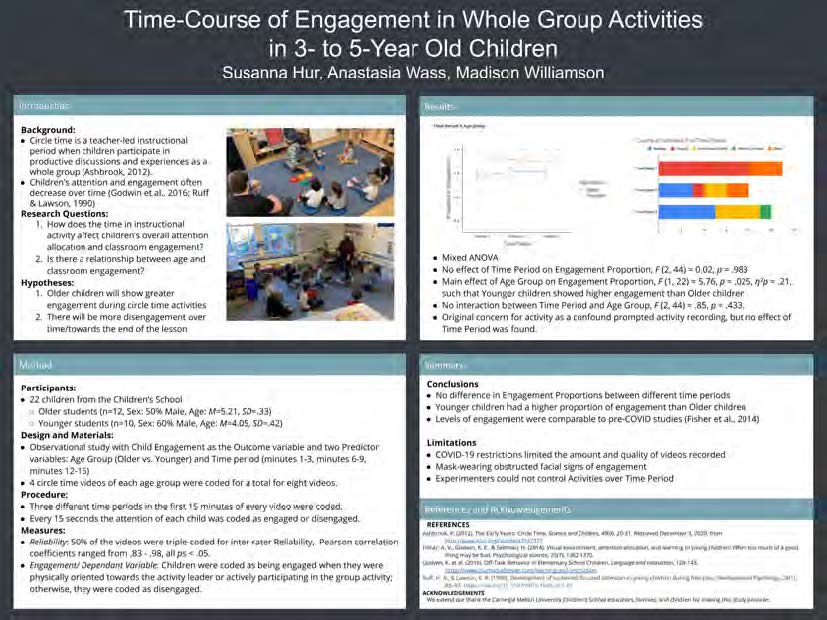
April 2021
Research Goes Remote
During the 2020-2021 school year, almost all of our developmental psychology research at the Children’s School is being conducted remotely, and the researchers greatly appreciate the support of Children’s School families in facilitating these virtual research sessions in your homes. This photo shows what a typical session looks like with a researcher (Emma Gurchiek), a child, and a shared computer screen via Zoom. We hope to return to more consistent in-person research when we return to school in the fall.
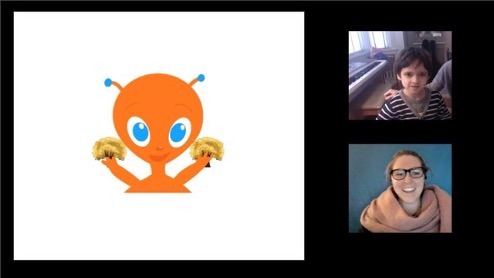
The Object Recognition Game
Dr. Vlad Ayzenberg and Dr. Marlene Behrman of the Visual Cognition Lab in the CMU Psychology department are studying the maturity of children’s object recognition. Children are the ultimate learning machines. With little prompting, they readily generalize their existing knowledge to never-before-seen situations – a feat not yet attained by even the most advanced artificial intelligence (AI) at Google. Yet, scientists still know very little about how children’s brains support such incredible feats of inference. For the current project, the researcher invites 3- to 6-year-old children to play a challenging visual recognition game. Children play a computer game where they see familiar objects (e.g., airplanes, balloons, dogs) in contexts they have not seen before. The objects will be presented very quickly (as fast as a 1/10th of a second!), and children will be asked to verbally identify the object (“What did you see?”), as well as specify the correct object when it is listed with a distractor (“Did you see a dog or a cow?”).
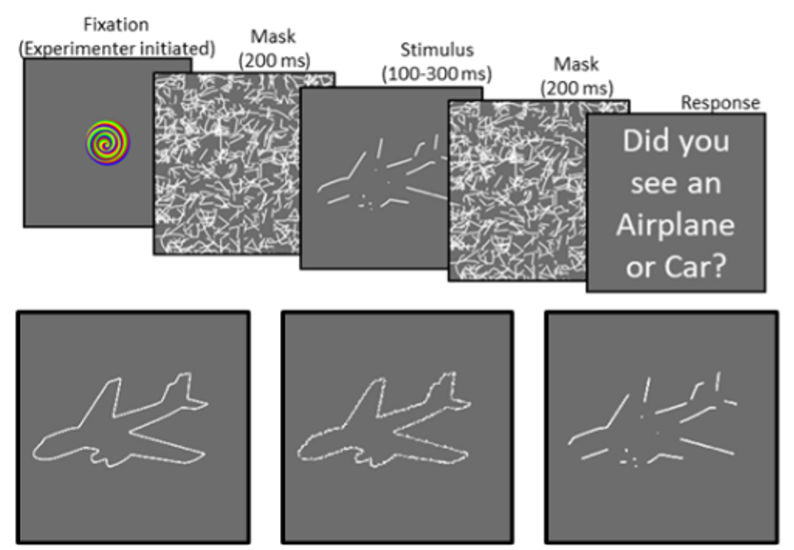
The 15-minute game is played three times on separate days. Each session is very similar, except that the context in which the objects appear changes. For example, on one day, the objects may be partially occluded; but on another day, they may be fully visible. By observing the difference in children’s performance across these conditions, the researchers can determine the maturity of children’s visual cortical brain areas, which might then be related to their ability to make inferences.
May 2021
The Matching Game
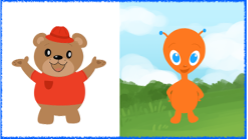 Emma Gurchiek, a research associate working with Dr. Catarina Vales and Dr. Anna Fisher, is conducting a remote study to examine how children’s knowledge in the domain of animals supports their ability to make inferences in that domain. In this study, researchers ask children to complete two games: In the first game, children help a bear sort cards with different plants and animals (e.g., peas, gorillas, etc.) and arrange the cards on their computer screen based on what they think goes together. Researchers use the spatial distance between items to infer which items a child thinks are more strongly related. In the second game, children help an Alien learn about the plants and animals on Earth by indicating which animals are more likely to share properties. Children will be told that an animal (e.g., a gorilla) is hiding behind a tree and has a fictional property (e.g., ‘hydracan eyes’). Then children decide which of two other things may also share that property (e.g., a hippo or lettuce). Using these two games, researchers can examine how children’s knowledge of animals underlies their guesses about unobservable properties of animals. The results of this study will help researchers better understand the way that children use their existing knowledge to learn new information.
Emma Gurchiek, a research associate working with Dr. Catarina Vales and Dr. Anna Fisher, is conducting a remote study to examine how children’s knowledge in the domain of animals supports their ability to make inferences in that domain. In this study, researchers ask children to complete two games: In the first game, children help a bear sort cards with different plants and animals (e.g., peas, gorillas, etc.) and arrange the cards on their computer screen based on what they think goes together. Researchers use the spatial distance between items to infer which items a child thinks are more strongly related. In the second game, children help an Alien learn about the plants and animals on Earth by indicating which animals are more likely to share properties. Children will be told that an animal (e.g., a gorilla) is hiding behind a tree and has a fictional property (e.g., ‘hydracan eyes’). Then children decide which of two other things may also share that property (e.g., a hippo or lettuce). Using these two games, researchers can examine how children’s knowledge of animals underlies their guesses about unobservable properties of animals. The results of this study will help researchers better understand the way that children use their existing knowledge to learn new information.
The Teach Poko Words Game
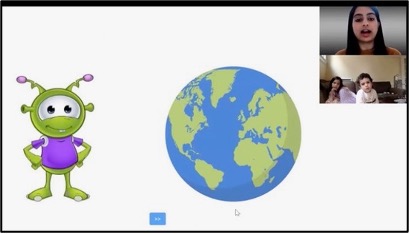 Tania Dhaliwal, a research associate working with Dr. Anna Fisher and Dr. Bonnie Nozari, is conducting a remote study of word comprehension. When we speak, our ability to produce the correct word is affected by the words we produced previously, and by the relations among these words. In this study, researchers examine how word comprehension in children is affected when words presented together share features (for example, dog and cat that are both animals, are furry, have four legs, etc.), or when words presented together share a similar context (for example, dog and leash that have no shared features but are likely to occur together in the world), or when words are unrelated to each other (for example, dog and fork).
Tania Dhaliwal, a research associate working with Dr. Anna Fisher and Dr. Bonnie Nozari, is conducting a remote study of word comprehension. When we speak, our ability to produce the correct word is affected by the words we produced previously, and by the relations among these words. In this study, researchers examine how word comprehension in children is affected when words presented together share features (for example, dog and cat that are both animals, are furry, have four legs, etc.), or when words presented together share a similar context (for example, dog and leash that have no shared features but are likely to occur together in the world), or when words are unrelated to each other (for example, dog and fork).
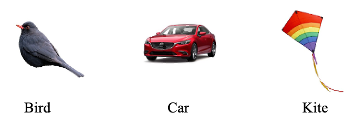 The researcher introduces children to a picture of a friendly alien named Poko who is visiting Earth to learn some new words in English. Poko needs to practice and needs the children’s help to remember the words he learned, so children are asked to tell Poko if the names he says for pictures shown on the screen are correct, and to reply as fast as they can. Children will hear audio of an English word and then immediately see a picture, and children respond with ‘yes’ or ‘no’ as fast as possible to tell Poko whether the word they heard matched the picture or not. The results of this experiment can help us better understand the development of knowledge organization in the brain and how it is linked to language.
The researcher introduces children to a picture of a friendly alien named Poko who is visiting Earth to learn some new words in English. Poko needs to practice and needs the children’s help to remember the words he learned, so children are asked to tell Poko if the names he says for pictures shown on the screen are correct, and to reply as fast as they can. Children will hear audio of an English word and then immediately see a picture, and children respond with ‘yes’ or ‘no’ as fast as possible to tell Poko whether the word they heard matched the picture or not. The results of this experiment can help us better understand the development of knowledge organization in the brain and how it is linked to language.




